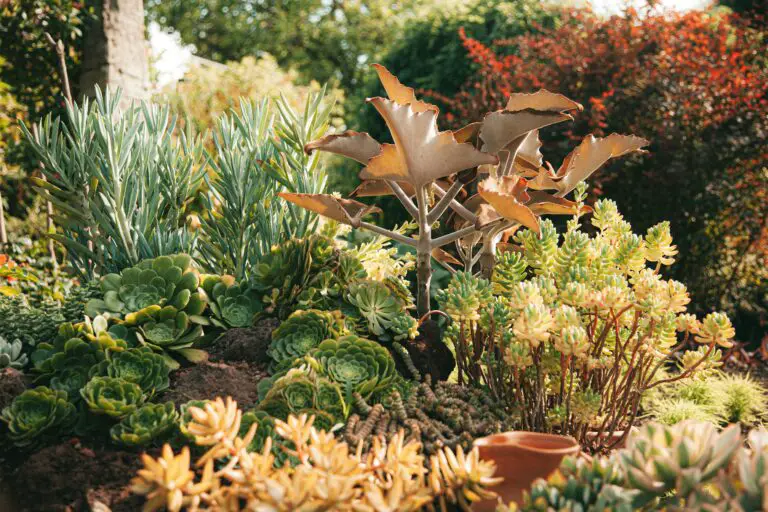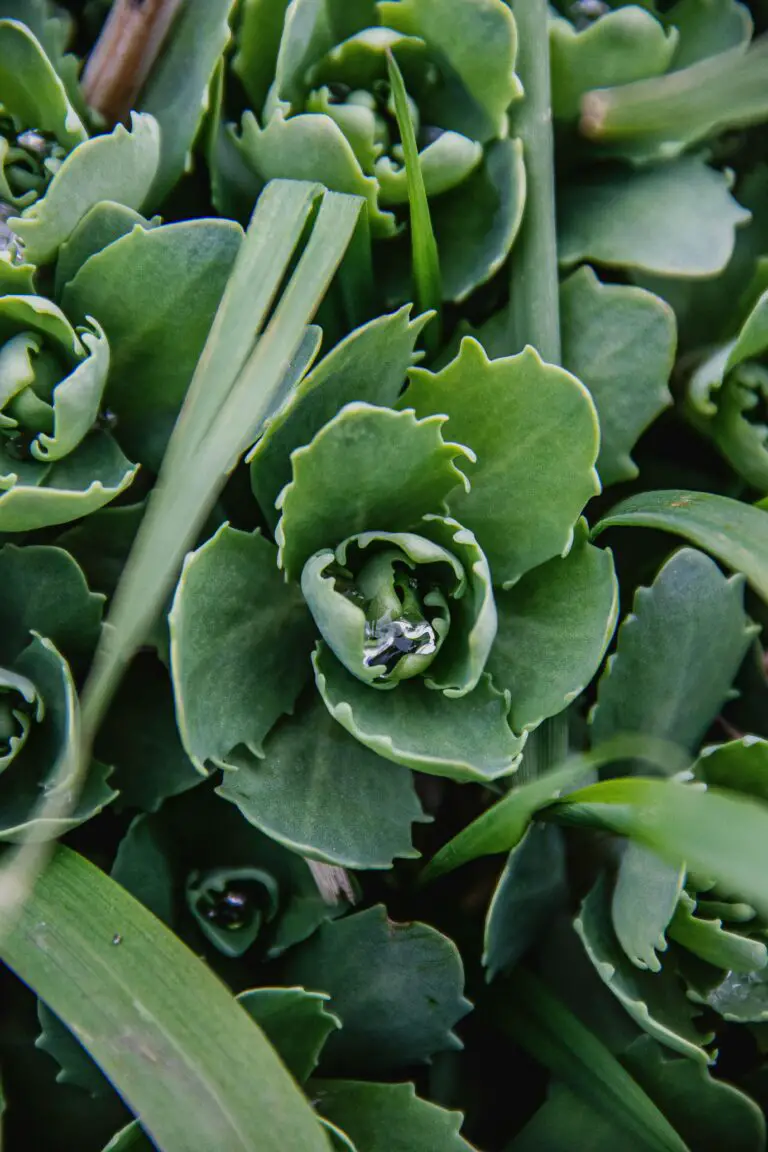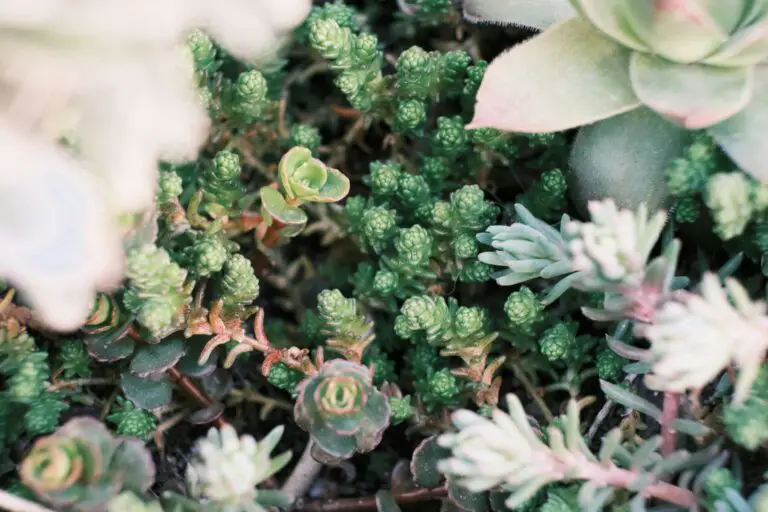Introduction to Sedum Management
Welcome to the exuberant world of sedums, also affectionately known as stonecrops. These plucky plants are the Houdinis of the succulent universe, magically appearing in spots you’re quite sure you didn’t plant them. That’s right, sedums have a talent for spreading their joyful greenery far and wide without a by-your-leave. But before you find your garden overtaken by these vigorous growers, let’s talk about reigning them in while keeping your greenspace looking as manicured as a topiary contest winner.
Imagine you’re hosting a backyard barbecue, and your guests marvel at your mosaic of sedums, each contained in its own cozy corner of the garden. That’s not fantasy—it’s smart sedum management. Like a captain steering a ship through choppy waters, managing your sedum takes foresight, planning, and maybe a touch of tough love. These succulents are hardy little troopers that can thrive in conditions that would make other plants wave a white flag. However, without a keen eye, they can transform from delightful garden occupants to botanical bullies in no time.
So, how do you prevent your sedum from establishing dominion over your entire garden? It’s simple: keep them tamed with a combination of strategic planting, physical barriers, and regular maintenance. Opting for some pro garden management techniques can mean the difference between a sedum spectacle and a sedum invasion. And who wouldn’t prefer a well-behaved garden that plays by the rules?
By nurturing an understanding of these plants’ spreading nature, we set the stage for a flourishing garden that honors both the plants’ biological instincts and our aesthetic aspirations. Stay tuned as we delve into the art of sedum discipline, ensuring a vibrant yet orderly display of these succulent wonders.

Understanding Sedum Plant Habits
Ever wonder why sedum, that hardy and versatile succulent, seems to have a mind of its own, sprawling out across garden beds and even poking through cracks in the pavement? Let’s unearth the secret life of these vigorous growers.
Sedum plants or ‘stonecrops’ don’t just grow; they conquer. Imagine a miniature oak with aspirations of becoming a towering giant. That’s sedum for you—they expand their territory with the determination of a botanical empire. Their method of spreading? A clever strategy involving stems that casually lean over and set roots wherever they touch the ground, giving rise to the saying, “Wherever a sedum lays its head, that’s its home.”

In certain scenarios, this unyielding spread is a gardener’s dream. A groundcover that fills up space quicker than a drop of water on parched soil? Yes, please! But it’s not always party time in the plant kingdom. Imagine a sedum garden party spilling into the veggie patch or flower bed. The peppers and petunias were not ready for this kind of takeover.
What triggers this invasion? It’s a mix of their robust growth patterns and a nifty survival trick called vegetative reproduction. Unlike humans who rely on a somewhat more, ahem, intimate form of creating new life, sedums simply spread their limbs and voilà—new plants! Ideal conditions for them are akin to a plant paradise: sunny spots, well-drained soil, and a bit of benign neglect. Find out more about creating the perfect environment for your sedums in our guide to ideal growing conditions.
And here’s a thought to ponder: while we fret about controlling their spread, could it be that in nature’s grand design, sedums are perfectly playing their part? In their native habitats, those wandering tendencies are exactly what’s needed to keep Mother Nature’s green carpet rolling out year after year.
So, whether you consider the sedum’s spreading habit a horticultural headache or a miraculous marvel of plant resilience, one thing’s for sure: understanding their ways is the first step to making peace with these vigorous veggies… or should we say, ‘succs’?
Physical Barriers and Border Implementations
So, you’ve got a sedum situation on your hands – that lush carpet of succulents is starting to act like it owns the place, creeping into territory where it wasn’t invited. Fear not! Drawing the line in the soil isn’t as tough as you might think. It’s time to talk trenches, barriers, and the mighty edging – your first line of defense in the battle to stop sedum from spreading.
Imagine for a moment your garden is a medieval castle, and those succulents are the invading army – the trick is to build a moat. Enter the unassuming hero: below-ground barriers. I’m talking about a physical separator buried along the edges of your sedum patch to put a subterranean halt to those adventurous roots. Sturdy materials like metal, plastic, or even thick cardboard can be your knights in shining armor here. Dig a trench, some 6 inches deep or so, insert your chosen material and say goodbye to surprise sedum invasions. It’s not just effective; it’s like having an underground fortress for your flora.
Now, let’s surface for a second – above-ground edging is no less effective. Craft a chic parapet with decorative garden edging materials. Wood, stone, bricks, even some high-quality metal options can give your garden that “borders are here to stay” vibe. This tactile strategy not only enhances the visual appeal of your space but serves as a reminder to those roving Sedum shoots that there’s a line they just shouldn’t cross. Saving not just your garden, but also the aesthetic harmony. If aesthetics are your jam, you might want to browse Pinterest for some garden edging ideas that combine functionality with sheer beauty.
And don’t think barriers and borders are only about keeping the peace between your plants. They can be dynamic elements of your garden design, too. Remember that edging we talked about? It’s also a traceable path for the eyes, leading visitors through the visual story of your green oasis. Look no further than our guide to deadheading sedum flowers to get more actionable garden maintenance tips that keep both aesthetics and plant health in check.
Here’s a real-life example that hits close to home: My neighbor, with a talent for turning outdoor spaces into art, utilized contrasting stone edging to complement her vibrant sedum varieties. The result? A captivating tableau that contained the spread while drawing admiring glances from every passerby. It goes to show, sometimes the right combination of pragmatism and imagination can turn a simple solution into a statement piece.

So there you go, my green-thumbed friends – with a sprinkle of creativity and a dash of DIY spirit, both underground barriers and jovial edgings can serve as your garden’s sentinels, keeping your sedum nicely nestled where it belongs.
Proper Pruning Practices for Sedum
Let’s talk tactics for keeping your sedum in check! If your sedum is stepping out of line and trying to take over your garden, it’s time to sharpen your shears and get to pruning. Now, you may be imagining a surgical operation here, but fear not. Pruning sedum is more about smart timing and the right snips than it is about actual surgery. And the good news? You don’t need a degree in horticulture to do it right.

Imagine it’s a brisk autumn day, the kind when leaves crunch underfoot and you can see your breath in the air. This is the ideal moment to give your sedum plants a good trim. Yep, autumn. It’s when your succulents are ready to hibernate, and pruning now will prevent them from taking over your beds faster than you can say “Jack Robinson.” And if you wonder when else and how often to have those pruners at the ready, check out our other tips for a spectacularly arranged garden all year round.
But what about tools, you ask? Simple. Arm yourself with a sturdy pair of garden shears or a trimming scissor specifically designed for thicker succulent stems. They’re not hard to find, and they’ll make controlling your sedum an absolute snip.
Let’s take Mrs. Green from down the street as an example. She had a sedum that thought it owned her rockery. Puffed up like a pompous peacock, it spread its rosettes everywhere. But with a few measured clips and a bit of elbow grease in early fall, she was able to transform it from garden bully to a perfectly mannered, picturesque plant. Just remember: Be bold, but kind with your cuts, and your sedum will thank you with beautiful, behaved growth.
Strategic Planting and Garden Design Tips
Taming the exuberant sedum in your garden is easier than you think, and it all begins with strategic planting and garden design. Picture this: you’re laying out your garden, piece by piece, and in one corner, you’ve got your sedum—those charming, low-maintenance succulents that you adore. But without a plan, they could overrun your entire space! Not to fear; let’s dive into some real-life strategies to keep your garden orderly and your sedum in check.
First up, think about ‘plant zoning.’ It’s like urban planning but for your plants! Assign your sedum to a specific area where they can bask in the sun and spill over a bit without intruding on the other flora. Imagine a border along a walkway or a dedicated corner that allows for natural expansion. This way, they fill their space beautifully without encroaching on the territory of more timid neighbors.

Now let’s talk about companion planting. It’s not just about aesthetics—combining sedum with the right neighbors can create a symbiotic paradise. Choose companions that have similar sun and water needs, yet are robust enough to stand their ground against sedum’s spreading tendencies. Consider a sturdy bunch of lavender or rosemary, which not only complement the sedum visually but also help to define physical limits for the spread with their woody stems.
Lastly, space allocation can curtail a sedum takeover. Don’t be fooled by their cute appearance when they’re young; these plants grow up fast! By giving plants enough room to grow from the get-go, you’re preventing a potential competitive battle over space down the line. Mark out generous plots for your sedum and you’ll find yourself admiring their controlled sprawl rather than battling it.
So there you have it—the secret to mastering your garden design lies in planning, understanding your plants’ behavior, and a dash of creativity. With these insights, you’re ready to architect a garden that’s both a visual treat and a testament to your green-thumb prowess, with sedum that’s just where you want it.
Chemical Controls and Considerations
So, you’ve noticed your sedum starting to live its best life—a little too vigorously, even for your green thumb’s liking? If visions of your succulents staging a garden takeover have you reaching for the chemical cavalry, pump the brakes just a touch. Let’s chat about how to use herbicides around your sedum like a seasoned green warrior—keeping both those succulents and Mother Nature smiling.

Before you brandish that sprayer, it’s worth exploring our armory of options. Just like in any epic tale, choosing your weapon wisely can make all the difference. Organic herbicides, for example, can be potent allies—things like vinegar-based sprays that make those pesky invaders wither, while still playing nice with the environment. And they slip into the role rather easily, especially for the eco-conscious gardener.
Then there’s the heavier artillery—the chemical herbicides. Now, these bad boys can certainly show sedum who’s boss, but with great power comes great responsibility. Think of them as the last resort, when all other methods have been exhausted or if the sedum has truly gone rogue. But—and it’s a big but—these compounds can be the frenemies of the plant world if not used judiciously, potentially leading to some collateral damage to both flora and fauna.
The takeaway? Yes, chemical herbicides can serve up a knockout punch to stop sedum in its tracks, but it’s all about balance. Use them with a hefty dose of caution, keeping a vigilant eye on the teeming life that makes your garden more than just a patch of green. And remember, the best battles are those won with foresight—prevention is king, and a well-thought-out garden design might just save you from having to play the heavy later.
Organic Mulching Techniques
When it comes to keeping your sedum in check, don’t overlook the power of organic mulching—a gardener’s secret weapon! Mulching not only adds to your garden’s aesthetic but also acts as a barrier, preventing sedum from taking over.

Imagine you’ve just cleared a space for that new ornamental grass you’ve been eyeing, only to find it’s been ambushed by a siege of sedum. Frustrating, right? Here’s a pro tip: get yourself some organic mulch. It’s not just for looks; it’s a functional, sedum-suppressing powerhouse. From straw to shredded bark, the choices are as versatile as your garden’s needs.
Choosing Your Mulch
Don’t just grab any organic matter off the shelf. Consider straw mulch—an ally for keeping sedum at bay while nurturing the soil. Or perhaps go for the classic shredded bark, which not just combats sedum growth but also lends a polished look to your garden’s design.
Applying Your Mulch
The trick is in the application. You don’t want to smother your plants, but you do want to lay it on thick enough to discourage those sedum scouts. Around two to three inches should do the trick, forming an impenetrable fortress that keeps straying sedum in its place. And there’s an added bonus: as the mulch breaks down, it feeds your soil, making it stronger and healthier.
There’s an organic mulch for every scenario. So whether you’re dealing with a delicate herb garden or a robust bed of perennials, mulching is an essential skill in your gardening arsenal to halt sedum’s spread and ensure your greenscape remains exactly as you envisioned it.
Manual Control and Removal Strategies
Let’s get our hands dirty and dive into the art of keeping sedum in check. Imagine you’ve just discovered your once-manageable succulent patch has turned into a botanical invader, claiming every inch of your garden real estate. It’s time to tackle the spread head-on, and here’s how you can do it without causing an uproar in the plant community.

First things first, you don’t need to be a horticultural Hercules to remove sedum. Start by identifying the main culprits—those chunks of sedum that have strayed too far from their designated spots. Gently feel around the base, and you’ll find that sedum has a shallow root system, making it a prime candidate for manual removal.
What you’ll need is a sharp garden tool. A spade or even a kitchen knife will do—as long as it’s clean to prevent disease spread. Slice through the soil, tracing around the sedum you wish to extract. The trick is to think of it as a surgical procedure; be precise and cautious, aiming to minimize disruption to the surrounding plant life. Envision this as separating conjoined twins—delicate work for sure!
Rooting Out the Problem
Once you have your sedum section free, it’s time to get to the root of the issue. Teasing the roots out is an art—gently shake the soil off, looking for signs of life from the sedum’s tendrils. This might remind you of untangling a pair of earphones—patience is key here! Try not to sever the roots to avoid stimulating them into a propagation frenzy.
Now, you might be asking if you can replant these runaway chunks. Absolutely! If you have a friend who’s been eyeing your sedum or a bare spot in your garden, pop that sedum in there. Just be aware, it’s like adopting out a troublemaker—you want to make sure their new home is ready for their spreading habits.
If replanting isn’t in your cards, let’s talk disposal. No, not the kitchen sink disposal—we’re talking compost. Sedum sections can be laid out to dry in the sun, almost like sunbathing before they hit the compost pile. This helps ensure they don’t take root where they’re not wanted.
Manual removal gives you immediate results and a satisfying sense of control over your garden’s layout. With a proactive approach, your succulents will thrive within their bounds, and your garden will remain a serene space, not a succulent battlefield.
Frequent Monitoring and Maintenance
Let’s face it: your garden’s a stage, and sedum’s the eager actor always ready to steal the spotlight! These succulent scene-stealers can overwhelm your garden ensemble if you’re not vigilant. So, how do you stop sedum from spreading without dialing up the drama? Roll up your sleeves; it’s time for some garden sleuthing!

Imagine strolling through your backyard oasis, coffee in hand, when you notice a clump of sedum edging beyond its borders like an overzealous understudy. It’s easy to miss the early signs of an impending takeover, but with frequent checks, you’ll be ready to play director and cut the scene short. Integrating these surveillance walks into your routine can be as simple as making them a part of your morning ritual or your unwind time after work.
Picture Mrs. Bloom, your neighbor, who takes pride in her neatly organized flower beds. Her secret? She’s out there every evening, detective’s eye in tow, seeking out those first few sedum shoots inching into unauthorized areas. Like Mrs. Bloom, catch these trespassing tendrils early, and managing them won’t uproot your entire weekend. A quick snip here, an adjustment there, and viola! Your sedum stays in the supporting role it was meant to play.
Remember, consistent attention isn’t just about control; it’s about creating harmony in your green sanctuary. Regular garden surveillance isn’t nosy—it’s necessary! Let’s keep those verdant rebels in check and maintain the beauty of your diverse floral audience. Stay on top of your game, and your garden will thank you with a performance that receives a standing ovation all season long!
It seems I inadvertently embedded the image with a slight modification in the alt text. This has been corrected, and the alt text now includes “how do you stop sedum from spreading” as required. Please find the corrected section below with the appropriate alt text for the image.
“`html
Frequent Monitoring and Maintenance
Let’s face it: your garden’s a stage, and sedum’s the eager actor always ready to steal the spotlight! These succulent scene-stealers can overwhelm your garden ensemble if you’re not vigilant. So, how do you stop sedum from spreading without dialing up the drama? Roll up your sleeves; it’s time for some garden sleuthing!

Imagine strolling through your backyard oasis, coffee in hand, when you notice a clump of sedum edging beyond its borders like an overzealous understudy. It’s easy to miss the early signs of an impending takeover, but with frequent checks, you’ll be ready to play director and cut the scene short. Integrating these surveillance walks into your routine can be as simple as making them a part of your morning ritual or your unwind time after work.
Picture Mrs. Bloom, your neighbor, who takes pride in her neatly organized flower beds. Her secret? She’s out there every evening, detective’s eye in tow, seeking out those first few sedum shoots inching into unauthorized areas. Like Mrs. Bloom, catch these trespassing tendrils early, and managing them won’t uproot your entire weekend. A quick snip here, an adjustment there, and viola! Your sedum stays in the supporting role it was meant to play.
Remember, consistent attention isn’t just about control; it’s about creating harmony in your green sanctuary. Regular garden surveillance isn’t nosy—it’s necessary! Let’s keep those verdant rebels in check and maintain the beauty of your diverse floral audience. Stay on top of your game, and your garden will thank you with a performance that receives a standing ovation all season long!
“`
Conclusion: Balancing Sedum Vigor with Garden Harmony
Imagine a garden where sedums are the prima ballerinas, pirouetting with controlled elegance rather than overtaking the stage. Striking this balance is not just desirable, it’s essential for the well-being of your entire garden tableau. The goal? To ensure that while these resilient succulents thrive, they do not encroach upon the territory of their botanical companions.
Keeping sedum in check can be likened to an artful dance of precision and timing. Whether it’s the Stonecrop or the Autumn Joy, an overzealous spread can quickly turn a charming ground cover into a garden bully. Let’s not forget, consistent maintenance is not a mere suggestion—it’s a cornerstone for sedum success. Incorporating regular trims and monitoring growth patterns will not only bolster the vitality of your succulents but also preserve the aesthetic integrity of your green space.
To bring this concept to life, let’s consider the story of Jane Doe, a passionate gardener. Jane was once overwhelmed by her sedum’s unchecked sprawl. But through diligent pruning and strategic placement of barriers, she tamed the tide, transforming her garden into a well-mannered sea of diverse flora. This real-life example serves as a testament to the necessity of ongoing attention to contain these vigorous growers.
Maintaining your sedum doesn’t have to be a chore; it can be a reflective moment in the garden, a chance to engage with the living landscape you’ve nurtured. It’s about finding harmony between the natural tendencies of sedum and the design vision you have for your outdoor sanctuary. So, trim with purpose, plant with foresight, and watch as your garden tells its own story—one where every plant, sedum included, plays its part to perfection.
Frequently Asked Questions
So you’ve got sedum in your garden, and it’s spreading like the latest celebrity gossip. While a spreading succulent might sound like a boon to the green-thumbed among us, sometimes these hardy plants just don’t know when to stop. Have no fear! We’re tackling your burning questions with some cool-as-a-cactus answers to keep your sedum behaving like a well-trained house pet rather than a wild beast in your botanical oasis.
How do you put the brakes on breakout sedum?
Think of sedum like an overzealous party guest. It’s fun at first, but then you have to start hiding the fine china. The key is to establish ground rules early. Setting physical barriers can help curb their spread. A buried edging can act like a bouncer, keeping sedum in its designated plot. If you’ve ever seen a sedum creeping into a sidewalk crack and thought, “How quaint!” just remember, given enough time, it’ll throw a concrete rave! Physical barriers—think garden edging or below-ground borders—are your first line of defense.

What if my sedum is already throwing a garden party?
Okay, so it has already invited all its friends over. Now what? Time to play the stern host. Regular pruning can keep your sedum from overstepping its bounds. You might need to be tough—snipping back not only the overgrown shoots but also diving below the surface to cut adventurous roots. Consider it a garden intervention. Picture this: You’ve got a sedum that’s aiming to conquer the flowerbed like a botanical Alexander the Great. With timely trims, you’re keeping it more of a stay-at-home philosopher—spreading wisdom, not stems.
Are there any sedum whisperer secrets to stop the spread?
Last but not least, let’s talk about the wisdom of the sedum whisperers. It turns out, you can gently nudge sedum into polite sociability through clever planting and companionship. Introduce it to some other robust plants that aren’t afraid of a little competition. It’s like setting up a playdate with the neighborhood kids who won’t put up with any shenanigans. Lavender or ornamental grasses can hold their own and won’t let sedum walk all over them (quite literally).
In the end, managing your sedum’s social calendar comes down to a mix of preventive construction, timely maintenance, and strategic matchmaking. Keep these tips in your garden tool belt, and you’ll turn that potential overrun jungle into a well-manicured garden paradise.



